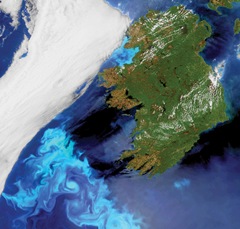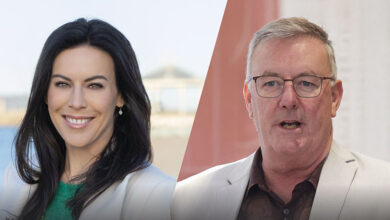A climate-changed land
 NUI Maynooth climatologist Professor John Sweeney updates eolas on what a warmer future could mean for Ireland’s scenery.
NUI Maynooth climatologist Professor John Sweeney updates eolas on what a warmer future could mean for Ireland’s scenery.
Ireland’s traditional landscape could be transformed as climate change determines which species can live on a warmer island. John Sweeney and his researchers are completing a three-year research project entitled: ‘Co-ordination, Communication and Adaptation for Climate Change in Ireland: an Integrated Approach’.
Research by Sweeney and his counterparts indicates that higher temperatures will bring about major changes to the island’s habitats and species.
“Climate change will produce significant changes in habitats and ecosystems by changing the viability of species,” Sweeney explains. “New entrants are likely to appear and some ecological niches will no longer exist.”
Ireland’s island status and the projected rate of climate change both increase the potential for extinction as species may not be able to migrate for survival. Our oceans, coasts, wetlands and mountains are all likely to be affected.
The “bounty of the sea” has a self-evident link with Ireland’s culture. “While sea temperatures will change more conservatively than those of the adjoining land, signs of a warmer ocean are already evident,” he says.
“Some inter-tidal species such as barnacles and some seaweeds are not likely to do well in warmer waters while some fish species such as mullet (Chelon labrosus) and bass (Dicentrarchus kabrus) may expand their range.
“More southerly species such as the trigger fish (Balistes carolinensis), garfish (Belone belone) and long fin tuna (Thunnus alalunga) may make more regular appearances off the south coast.”
Warmer winters will also increase seabird numbers, though their living conditions would be made more difficult by habitat loss in coastal marshes and increased wave action.
“Other species such as the little egret appear to be increasing their range throughout Atlantic Europe,” he continues. “On balance, projected climate change seems likely to result in a loss rather than a gain of seabird species.”
Atlantic salmon (Salmo salar) is also close to its southern limit in Europe and the loss of that species, if it occurred, would “represent the greatest psychological blow to most Irish people”. Research into salmon’s viability in a changing climate is now under way.
Onshore, salt marshes and sand dunes are at risk from rising sea levels and storm damage: “Plants such as saltmarsh flat sedge could well disappear, while common cordgrass could displace common saltmarsh grass, changing the character of this habitat.”
Drier dunes in the summer would damage the habitat for the variegated horsetail (Equisetum variegatum) and the Natterjack toad (Bufo calamita). Machair, a rare habitat which is a European conservation priority, “could also face difficulties.”
Drier wetlands
Moving inland, the turlough (a seasonal lake) is a distinctive landscape feature in western Ireland. Its water levels are controlled by groundwater, drying out in the summer and replenished by rising levels in winter. Earlier and more sustained summer drying would have an obvious effect.
“Ireland possesses a significant fraction of the world’s oceanic raised bogs and blanket bogs, and bogs constitute, in a sense, a cultural heritage resource intimately associated with the personality of Ireland,” he remarks. “Anything which reduces moisture availability or enhances summer drying out is detrimental to these habitats.”
A 1-2°C warming could reduce peat forming processes by 25 per cent, according to the Intergovernmental Panel on Climate Change; the problem is particularly acute in upland blanket bogs.
Peatlands are already fragile and less peat formation, along with increased decomposition rates, erosion and species loss will reduce their ability to store carbon.
While there are concerns that drying in summer will increase cracking and destabilisation, leading to more frequent bog slides, recent examples of these “appear to owe more to disturbance of the peat due to road construction associated with wind farm developments.”
Mountains are naturally cooler in temperature but montane heaths in those uplands are “particularly sensitive to warming”. Many of these habitats are at their southern limit and species cannot migrate to higher altitudes.
“Dwarf willows (Salix herbacea), stiff sedge (Carex bigelowii) are some of the plants at risk while heather expansion may reduce the bracken invasion of many uplands.” The Arctic char (Salvelinus alpinus) and pollan (Coregonus autumnalis) fish also have a “medium to high vulnerability” as they are relict species from Arctic and boreal habitats.
“Ireland possesses the last resident population of pollan in Europe, and, as well as threats from the invasive Zebra mussel, summer warming could adversely affect the spawning of pollan, which need water temperatures of less than 22°C,” Sweeney explains.
No time to lose
“Like many people, I came back from Copenhagen very disillusioned and very much disappointed with the way that the political priorities had shifted,” Sweeney comments. That said, he sees some positives from that conference which could carry over to the Cancún summit, which started on 29 November.
The Copenhagen Accord was not a comprehensive agreement, as had been anticipated, but does require individual countries to produce estimates for the reductions they are prepared to consider.
Sweeney also suggests that the EU “certainly has to try and play a more central role as an honest broker between the big bloc countries of the developed world and the big bloc countries of the developing world.”
Europe was “excluded” at last December’s talks but he is encouraged by the change in attitude in some previously sceptical countries: “We are seeing some of the big names shifting away from passive to active involvement.” Russia is taking climate change more seriously after the unprecedented summer fires. China and India are, though, “holding out to the bitter end.”
He finds that the Irish Government’s commitment to tackling the problem has improved over the last four to five years, even before the Green Party entered government.
“We had two rather anodyne national climate change strategies which really didn’t change very much on the ground,” he says, of the period before the 2007-2020 strategy was launched. “Unless we got serious about the issue, we would be paying very substantial fines for exceeding our Kyoto commitments.”
Many of the decisions about adapting to climate change must be made now, he emphasises. This includes increasing the water supply for urban areas, which has a 10-15 year lead time in planning and construction.
“We cannot wait for the experiment to happen to take action in a lot of areas,” he predicts. Adaptation also makes economic sense, and can give Ireland an advantage e.g. if farmers on the island can produce and grow crops more economically than their competitors.
“Ultimately if we haven’t got the urge or the will to adapt,” he adds, “we will certainly not be competitive in future in many sectors.”





